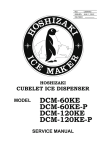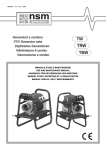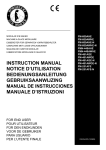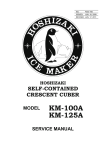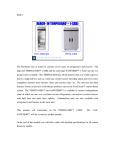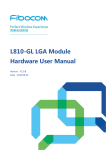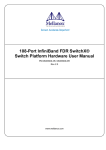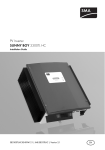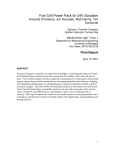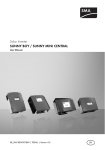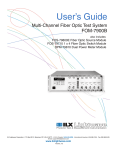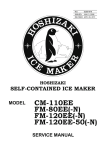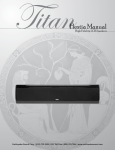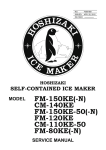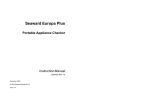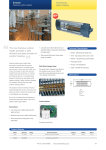Download FM-251AFE(-N)
Transcript
NO. E2BB-695 ISSUED: JAN. 24, 2006 REVISED: OCT. 12, 2007 HOSHIZAKI MODULAR ICE MAKER FM-251AFE(-N) FM-481AGE(-N) FM-481AWGE(-N) MODEL SERVICE MANUAL CONTENTS PAGE I. SPECIFICATIONS ------------------------------------------------------------------------------------- 1 1. FEATURES ---------------------------------------------------------------------------------------- 1 [a] LOW VOLTAGE ------------------------------------------------------------------------------ 1 [b] OVERLOAD PROTECTION --------------------------------------------------------------- 1 [c] OVERLOAD ERROR ------------------------------------------------------------------------ 1 [d] USER RESET --------------------------------------------------------------------------------- 1 [e] ERROR CODES AND RECORDS------------------------------------------------------- 1 [f] OTHER INFORMATION --------------------------------------------------------------------- 2 [g] CHANGE OF ICE TYPE -------------------------------------------------------------------- 2 2. DIMENSIONS/CONNECTIONS --------------------------------------------------------------- 3 [a] FM-251AFE, FM-251AFE-N -------------------------------------------------------------- 3 [b] FM-481AGE, FM-481AGE-N -------------------------------------------------------------- 4 [c] FM-481AWGE, FM-481AWGE-N -------------------------------------------------------- 5 [d] WITH STORAGE BIN (B-300_F)---------------------------------------------------------- 6 3. SPECIFICATIONS ------------------------------------------------------------------------------- 7 [a] FM-251AFE ----------------------------------------------------------------------------------- 7 [b] FM-251AFE-N -------------------------------------------------------------------------------- 8 [c] FM-481AGE ----------------------------------------------------------------------------------- 9 [d] FM-481AGE-N ------------------------------------------------------------------------------- 10 [e] FM-481AWGE ------------------------------------------------------------------------------- 11 [f] FM-481AWGE-N ---------------------------------------------------------------------------- 12 4. CONSTRUCTION -------------------------------------------------------------------------------- 13 [a] FM-251AFE(-N) ----------------------------------------------------------------------------- 13 [b] FM-481AGE/AWGE(-N) ------------------------------------------------------------------- 14 II. MAINTENANCE AND CLEANING INSTRUCTIONS ----------------------------------------- 15 1. EXTRUDING HEAD, HOUSING BEARING, AUGER BEARING ---------------------- 15 2. MECHANICAL SEAL --------------------------------------------------------------------------- 15 3. GEAR MOTOR ----------------------------------------------------------------------------------- 16 4. CONDENSER ------------------------------------------------------------------------------------ 16 5. AIR FILTER (AIR-COOLED MODEL ONLY) ----------------------------------------------- 16 6. WATER VALVE --------------------------------------------------------------------------------- 17 7. CLEANING OF WATER SYSTEM ----------------------------------------------------------- 18 8. PERIODICAL CLEANING --------------------------------------------------------------------- 20 III. TECHNICAL INFORMATION ---------------------------------------------------------------------- 21 1. WATER CIRCUIT AND REFRIGERANT CIRCUIT --------------------------------------- 21 [a] FM-251AFE(-N) ----------------------------------------------------------------------------- 21 [b] FM-481AGE(-N) ----------------------------------------------------------------------------- 22 [c] FM-481AWGE(-N) -------------------------------------------------------------------------- 23 2. WIRING DIAGRAM ------------------------------------------------------------------------------ 24 [a] WIRING DIAGRAM -------------------------------------------------------------------------- 24 [b] CONTROL BOX LAYOUT ----------------------------------------------------------------- 27 3. ICEMAKING MECHANISM -------------------------------------------------------------------- 30 [a] EVAPORATOR (CASING) ---------------------------------------------------------------- 30 i [b] AUGER ---------------------------------------------------------------------------------------- 30 [c] EXTRUDING HEAD (BEARING) --------------------------------------------------------- 31 [d] HOUSING ------------------------------------------------------------------------------------- 31 [e] MECHANICAL SEAL ---------------------------------------------------------------------- 31 [f] COUPLING (SPLINE JOINT) -------------------------------------------------------------- 31 [g] GEAR MOTOR ------------------------------------------------------------------------------- 31 [h] BELT HEATER ------------------------------------------------------------------------------ 31 [i] REMOVABLE FLANGE ------------------------------------------------------------------- 31 [j] SOCKET HEAD CAP SCREW ---------------------------------------------------------- 32 4. WATER CIRCUIT -------------------------------------------------------------------------------- 32 [a] RESERVOIR (WATER TANK) ----------------------------------------------------------- 32 [b] FLOAT SWITCH ----------------------------------------------------------------------------- 32 [c] CONTROL WATER VALVE -------------------------------------------------------------- 32 [d] FLUSH WATER VALVE ------------------------------------------------------------------- 33 [e] WATER REGULATOR --------------------------------------------------------------------- 33 [f] DRAINING ICEMAKER IN SUBFREEZING CONDITIONS ------------------------- 33 5. REFRIGERATION CIRCUIT ------------------------------------------------------------------- 34 [a] APPLICABLE PARTS --------------------------------------------------------------------- 34 [b] SERVICE INSTRUCTIONS --------------------------------------------------------------- 34 [c] REFRIGERANT ------------------------------------------------------------------------------ 35 [d] COMPRESSOR ----------------------------------------------------------------------------- 35 [e] EVAPORATOR CASING ------------------------------------------------------------------ 35 [f] CONDENSER -------------------------------------------------------------------------------- 35 [g] CONDENSER COOLING FAN MOTOR ----------------------------------------------- 36 [h] WATER REGULATOR --------------------------------------------------------------------- 37 [i] DRIER ------------------------------------------------------------------------------------------ 37 [j] THERMOSTATIC EXPANSION VALVE ----------------------------------------------- 37 6. ELECTRIC CIRCUIT ---------------------------------------------------------------------------- 38 [a] BASIC OPERATION ------------------------------------------------------------------------ 38 [b] TIMING CHART ------------------------------------------------------------------------------ 38 [c] SEQUENCE ---------------------------------------------------------------------------------- 40 [d] OPERATION BOARD ---------------------------------------------------------------------- 58 [e] CONTROLLER BOARD ------------------------------------------------------------------- 58 [f] SURGE ABSORBER ----------------------------------------------------------------------- 59 [g] CAPACITOR - XY FILTER ---------------------------------------------------------------- 59 [h] BIN CONTROL SWITCH ------------------------------------------------------------------- 59 [i] CHUTE SWITCH ---------------------------------------------------------------------------- 60 [j] DEICING HEATER (BELT HEATER) --------------------------------------------------- 60 7. OPERATION BOARD -------------------------------------------------------------------------- 61 [a] USER OPERATION ------------------------------------------------------------------------ 61 [b] SERVICE OPERATION -------------------------------------------------------------------- 61 8. PROTECTORS ---------------------------------------------------------------------------------- 65 [a] INDICATION ---------------------------------------------------------------------------------- 65 [b] PROTECTORS ------------------------------------------------------------------------------ 65 9. ERROR CODES --------------------------------------------------------------------------------- 68 10. PERFORMANCE DATA ---------------------------------------------------------------------- 70 [a] FM-251AFE ---------------------------------------------------------------------------------- 70 ii [b] FM-251AFE-N ------------------------------------------------------------------------------- 71 [c] FM-481AGE ---------------------------------------------------------------------------------- 72 [d] FM-481AGE-N ------------------------------------------------------------------------------- 73 [e] FM-481AWGE ------------------------------------------------------------------------------- 74 [f] FM-481AWGE-N ---------------------------------------------------------------------------- 75 IV. SERVICE DIAGNOSIS ---------------------------------------------------------------------------- 76 1. NO ICE PRODUCTION ------------------------------------------------------------------------- 76 2. LOW ICE PRODUCTION ---------------------------------------------------------------------- 78 3. OTHERS ------------------------------------------------------------------------------------------- 78 V. REMOVAL AND REPLACEMENT OF COMPONENTS ----------------------------------- 80 1. SERVICE FOR REFRIGERANT LINES ---------------------------------------------------- 80 [a] SERVICE INFORMATION ----------------------------------------------------------------- 80 [b] REFRIGERANT RECOVERY ------------------------------------------------------------ 81 [c] EVACUATION AND RECHARGE ------------------------------------------------------- 81 2. BRAZING ------------------------------------------------------------------------------------------ 82 3. COMPRESSOR --------------------------------------------------------------------------------- 83 4. DRIER ---------------------------------------------------------------------------------------------- 84 5. EXPANSION VALVE --------------------------------------------------------------------------- 85 6. WATER REGULATING VALVE - WATER-COOLED MODEL ONLY --------------- 86 7. EVAPORATOR ASSEMBLY ----------------------------------------------------------------- 87 8. CONTROL WATER VALVE ------------------------------------------------------------------ 91 9. FLUSH WATER VALVE ----------------------------------------------------------------------- 92 10. CONTROLLER BOARD ----------------------------------------------------------------------- 93 [a] MODIFICATION ------------------------------------------------------------------------------ 93 [b] REPLACEMENT ---------------------------------------------------------------------------- 93 iii I. SPECIFICATIONS 1. FEATURES [a] LOW VOLTAGE When the supply voltage is too low or surrounding high-current equipment starts up, the voltage in the icemaker may drop temporarily. In this case, the Compressor will fail to start, or the Gear Motor will lock during the icemaking operation. The locked Gear Motor may apply the maximum torque to the icemaking mechanism and damage its parts. To avoid this trouble, the icemaker will be shut down when the voltage drops. The icemaker will restart automatically when the proper voltage is restored. [b] OVERLOAD PROTECTION The auger type icemaker employs the Gear Motor generating a large torque to scrape ice forming inside the Evaporator. To produce nugget ice, the Extruding Head also requires a large torque to compress ice. Some use conditions may overload the icemaking mechanism. The icemaker will detect overload by reduction in Gear Motor rotation speed and partly bypass the refrigerant flow in the refrigeration circuit. This will temporarily reduce the ice production to avoid the overload condition. [c] OVERLOAD ERROR When the above protection fails to evade the overload condition and the Gear Motor has a high current and a low rotation speed, the icemaker will shut down for protection. The icemaking mechanism will have extensive damage, if this condition is repeated ten times. In this case, the icemaker will display an error code to notify the user of the excessive load on the icemaking mechanism and the need of its replacement. [d] USER RESET When a protector trips to shut down the icemaker, an error code will be displayed. If it is a resettable error, the user can restart the icemaker by pressing the Reset Button accessible from the Window Panel and continue the icemaking operation until a service person arrives. Some errors are non-resettable or repetitive and require troubleshooting by qualified personnel. [e] ERROR CODES AND RECORDS When the icemaker shuts down with an error, the Display Window will show an error code “E_”. A maximum of eight most recent records are memorized and can be checked at the time of service or inspection. 1 [f] OTHER INFORMATION Other information is also available from the Controller Board. See “III. 7. OPERATION BOARD” for details. [g] CHANGE OF ICE TYPE With the older models, changes between flake ice and nugget ice were available by replacing the Extruding Head and Cutter. With the new models, not only the Extruding Head and Cutter but also the refrigeration circuit is different between the flake ice model and nugget ice model. To ensure the proper capacity and prevent a trouble with excessive ice production, do not replace the Extruding Head and Cutter to change the ice type. 2 2. DIMENSIONS/CONNECTIONS Top View [a] FM-251AFE, FM-251AFE-N 3 Top View [b] FM-481AGE, FM-481AGE-N 4 Top View [c] FM-481AWGE, FM-481AWGE-N 5 [d] WITH STORAGE BIN (B-300_F) 6 3. SPECIFICATIONS [a] FM-251AFE AC SUPPLY VOLTAGE 1 PHASE 220-240V 50/60Hz 1 PHASE 240V 50Hz AMPERAGE 5.4/4.4A (Ambient temp. 32°C, Water temp. 21°C) STARTING AMPERAGE 19/16A ELECTRIC CONSUMPTION 830/890W (Ambient temp. 32°C, Water temp. 21°C) POWER FACTOR 64/84% POWER SUPPLY CAPACITY Min 1.62/1.68kVA (6.8/6.0A) ICE PRODUCTION PER 24h Approx. 246/267 kg (Ambient temp. 10°C, Water temp. 10°C) Approx. 200/224 kg (Ambient temp. 21°C, Water temp. 15°C) Approx. 164/171 kg (Ambient temp. 32°C, Water temp. 21°C) WATER CONSUMPTION PER 24h Approx. 0.251/0.272 m3 (Ambient temp. 10°C, Water temp. 10°C) Approx. 0.205/0.229 m3 (Ambient temp. 21°C, Water temp. 15°C) Approx. 0.169/0.176 m3 (Ambient temp. 32°C, Water temp. 21°C) SHAPE OF ICE Flake MAX. STORAGE CAPACITY Not Applicable DIMENSIONS (DRAWING No.) 560(W) x 700(D) x 780(H) EXTERIOR Stainless Steel, Galvanized Steel (Rear) INSULATION Polyurethane Foam CONNECTION - ELECTRIC Y-type Con. (with Plug) - WATER SUPPLY Inlet G 3/4” (Connected at rear) - DRAIN Outlet R 3/4” x 2 (Connected at rear) ICE MAKING SYSTEM Auger type HARVESTING SYSTEM Direct driven Auger (80W Gear Motor) COMPRESSOR Hermetic Compressor 495W Model SC12DL CONDENSER Fin and Tube type, forced air cooling HEAT REJECTION 1325W EVAPORATOR Copper Tube on Cylinder REFRIGERANT CONTROL Thermostatic Expansion Valve REFRIGERANT CHARGE R404A 505g BIN CONTROL SYSTEM Mechanical Bin Control (Time Delay Controlled) ICE MAKING WATER CONTROL Float Switch and Water Valve ELECTRICAL PROTECTION Class I Appliance Manual-reset 10A Circuit Breaker COMPRESSOR PROTECTION Auto-reset Overload Protector, Auto-reset Pressure Switch GEAR MOTOR PROTECTION Manual-reset Circuit Breaker, Auto-reset Thermal Protector LOW WATER PROTECTION Float Switch and Timer BIN CONTROL PROTECTION Mechanical Switch WEIGHT Net weight 86 kg / Gross weight 98 kg PACKAGE Carton 671mm(W) x 820mm(D) x 910mm(H) ACCESSORIES Scoop, Installation Kit OPERATION CONDITIONS AMBIENT TEMP. 5-40°C WATER SUPPLY TEMP. 5-35°C WATER SUPPLY PRESSURE 0.5-8 bar (0.05-0.8MPa) We reserve the right to make changes in specifications and design without prior notice. 7 [b] FM-251AFE-N AC SUPPLY VOLTAGE AMPERAGE STARTING AMPERAGE ELECTRIC CONSUMPTION POWER FACTOR POWER SUPPLY CAPACITY ICE PRODUCTION PER 24h 1 PHASE 220-240V 50Hz 5.4A (Ambient temp. 32°C, Water temp. 21°C) 19A 830W (Ambient temp. 32°C, Water temp. 21°C) 64% Min 1.62kVA (6.8A) Approx. 236 kg (Ambient temp. 10°C, Water temp. 10°C) Approx. 192 kg (Ambient temp. 21°C, Water temp. 15°C) Approx. 158 kg (Ambient temp. 32°C, Water temp. 21°C) WATER CONSUMPTION PER 24h Approx. 0.241 m3 (Ambient temp. 10°C, Water temp. 10°C) Approx. 0.197 m3 (Ambient temp. 21°C, Water temp. 15°C) Approx. 0.163 m3 (Ambient temp. 32°C, Water temp. 21°C) SHAPE OF ICE Nugget MAX. STORAGE CAPACITY Not Applicable DIMENSIONS (DRAWING No.) 560(W) x 700(D) x 780(H) EXTERIOR Stainless Steel, Galvanized Steel (Rear) INSULATION Polyurethane Foam CONNECTION - ELECTRIC Y-type Con. (with Plug) - WATER SUPPLY Inlet G 3/4” (Connected at rear) - DRAIN Outlet R 3/4” x 2 (Connected at rear) ICE MAKING SYSTEM Auger type HARVESTING SYSTEM Direct driven Auger (80W Gear Motor) COMPRESSOR Hermetic Compressor 495W Model SC12DL CONDENSER Fin and Tube type, forced air cooling HEAT REJECTION 1325W EVAPORATOR Copper Tube on Cylinder REFRIGERANT CONTROL Thermostatic Expansion Valve REFRIGERANT CHARGE R404A 505g BIN CONTROL SYSTEM Mechanical Bin Control (Time Delay Controlled) ICE MAKING WATER CONTROL Float Switch and Water Valve ELECTRICAL PROTECTION Class I Appliance Manual-reset 10A Circuit Breaker, 13A Fuse built in UK Plug COMPRESSOR PROTECTION Auto-reset Overload Protector, Auto-reset Pressure Switch GEAR MOTOR PROTECTION Manual-reset Circuit Breaker, Auto-reset Thermal Protector LOW WATER PROTECTION Float Switch and Timer BIN CONTROL PROTECTION Mechanical Switch WEIGHT Net weight 86 kg / Gross weight 98 kg PACKAGE Carton 671mm(W) x 820mm(D) x 910mm(H) ACCESSORIES Scoop, Installation Kit OPERATION CONDITIONS AMBIENT TEMP. 5-40°C WATER SUPPLY TEMP. 5-35°C WATER SUPPLY PRESSURE 0.5-8 bar (0.05-0.8MPa) We reserve the right to make changes in specifications and design without prior notice. 8 [c] FM-481AGE AC SUPPLY VOLTAGE AMPERAGE STARTING AMPERAGE ELECTRIC CONSUMPTION POWER FACTOR POWER SUPPLY CAPACITY ICE PRODUCTION PER 24h 1 PHASE 230V 50Hz 7.5A (Ambient temp. 32°C, Water temp. 21°C) 30.5A 1522W (Ambient temp. 32°C, Water temp. 21°C) 88% Min 3.1kVA (13.3A) Approx. 500 kg (Ambient temp. 10°C, Water temp. 10°C) Approx. 425 kg (Ambient temp. 21°C, Water temp. 15°C) Approx. 325 kg (Ambient temp. 32°C, Water temp. 21°C) WATER CONSUMPTION PER 24h Approx. 0.500 m3 (Ambient temp. 10°C, Water temp. 10°C) Approx. 0.425 m3 (Ambient temp. 21°C, Water temp. 15°C) Approx. 0.325 m3 (Ambient temp. 32°C, Water temp. 21°C) SHAPE OF ICE Flake MAX. STORAGE CAPACITY Not Applicable DIMENSIONS (DRAWING No.) 560(W) x 699(D) x 780(H) (348158) EXTERIOR Stainless Steel, Galvanized Steel (Rear) INSULATION Polyurethane Foam CONNECTION - ELECTRIC Y-type Con. (with Plug) - WATER SUPPLY Inlet G 3/4” (Connected at rear side) - DRAIN Outlet R 3/4” x 2 (Connected at rear side) ICE MAKING SYSTEM Auger type HARVESTING SYSTEM Direct driven Auger (200W Gear Motor) COMPRESSOR Hermetic Compressor Model RS80C2E-CAZ-219 CONDENSER Fin and Tube type forced air cooling HEAT REJECTION 3150W (Ambient temp. 32°C, Water temp. 21°C) EVAPORATOR Copper Tube on Cylinder REFRIGERANT CONTROL Thermostatic Expansion Valve REFRIGERANT CHARGE R404A 770g BIN CONTROL SYSTEM Mechanical Bin Control (Time Delay Controlled) ICE MAKING WATER CONTROL Float Switch and Water Valve ELECTRICAL PROTECTION Class I Appliance COMPRESSOR PROTECTION Auto-reset Overload Protector, Auto-reset Pressure Switch GEAR MOTOR PROTECTION Manual-reset Circuit Breaker, Auto-reset Thermal Protector LOW WATER PROTECTION Float Switch and CM Controller BIN CONTROL PROTECTION Mechanical Switch WEIGHT Net weight 97 kg / Gross weight 118 kg PACKAGE Carton 671mm(W) x 820mm(D) x 910mm(H) ACCESSORIES Scoop, Mounting Bracket, Installation Kit OPERATION CONDITIONS AMBIENT TEMP. 5-40°C WATER SUPPLY TEMP. 5-35°C WATER SUPPLY PRESSURE 0.5-8 bar (0.05-0.8MPa) VOLTAGE RANGE Rated Voltage ± 10% We reserve the right to make changes in specifications and design without prior notice. 9 [d] FM-481AWGE AC SUPPLY VOLTAGE AMPERAGE STARTING AMPERAGE ELECTRIC CONSUMPTION POWER FACTOR POWER SUPPLY CAPACITY ICE PRODUCTION PER 24h 1 PHASE 230V 50Hz 6.7A (Ambient temp. 32°C, Water temp. 21°C) 30.5A 1321W (Ambient temp. 32°C, Water temp. 21°C) 86% Min 3.1kVA (13.3A) Approx. 420 kg (Ambient temp. 10°C, Water temp. 10°C) Approx. 380 kg (Ambient temp. 21°C, Water temp. 15°C) Approx. 340 kg (Ambient temp. 32°C, Water temp. 21°C) WATER CONSUMPTION PER 24h Approx. 2.022 m3 (Ambient temp. 10°C, Water temp. 10°C) Approx. 2.244 m3 (Ambient temp. 21°C, Water temp. 15°C) Approx. 2.822 m3 (Ambient temp. 32°C, Water temp. 21°C) SHAPE OF ICE Flake MAX. STORAGE CAPACITY Not Applicable DIMENSIONS (DRAWING No.) 560(W) x 699(D) x 780(H) (348159) EXTERIOR Stainless Steel, Galvanized Steel (Rear) INSULATION Polyurethane Foam CONNECTION - ELECTRIC Y-type Con. (with Plug) - WATER SUPPLY Inlet G 3/4” (Connected at rear side) Cond. Inlet Rc 1/2” (Connected at rear side) - DRAIN Outlet R 3/4” x 2 (Connected at rear side) Cond. Outlet Rc 3/8” (Connected at rear side) ICE MAKING SYSTEM Auger type HARVESTING SYSTEM Direct driven Auger (200W Gear Motor) COMPRESSOR Hermetic Compressor Model RS80C2E-CAZ-219 CONDENSER Water cooled, Tube in Tube Type EVAPORATOR Copper Tube on Cylinder REFRIGERANT CONTROL Thermostatic Expansion Valve REFRIGERANT CHARGE R404A 450g BIN CONTROL SYSTEM Mechanical Bin Control (Time Delay Controlled) ICE MAKING WATER CONTROL Float Switch and Water Valve ELECTRICAL PROTECTION Class I Appliance COMPRESSOR PROTECTION Auto-reset Overload Protector, Auto-reset Pressure Switch GEAR MOTOR PROTECTION Manual-reset Circuit Breaker, Auto-reset Thermal Protector LOW WATER PROTECTION Float Switch and CM Controller BIN CONTROL PROTECTION Mechanical Switch WEIGHT Net weight 97 kg / Gross weight 118 kg PACKAGE Carton 671mm(W) x 820mm(D) x 910mm(H) ACCESSORIES Scoop, Mounting Bracket, Installation Kit OPERATION CONDITIONS AMBIENT TEMP. 5-40°C WATER SUPPLY TEMP. 5-35°C WATER SUPPLY PRESSURE 0.5-8 bar (0.05-0.8MPa) VOLTAGE RANGE Rated Voltage ± 10% We reserve the right to make changes in specifications and design without prior notice. 10 [e] FM-481AGE-N AC SUPPLY VOLTAGE AMPERAGE STARTING AMPERAGE ELECTRIC CONSUMPTION POWER FACTOR POWER SUPPLY CAPACITY ICE PRODUCTION PER 24h 1 PHASE 230V 50Hz 7.15A (Ambient temp. 32°C, Water temp. 21°C) 30.5A 1464W (Ambient temp. 32°C, Water temp. 21°C) 89% Min 2.2kVA (9.6A) Approx. 430 kg (Ambient temp. 10°C, Water temp. 10°C) Approx. 360 kg (Ambient temp. 21°C, Water temp. 15°C) Approx. 290 kg (Ambient temp. 32°C, Water temp. 21°C) WATER CONSUMPTION PER 24h Approx. 0.430 m3 (Ambient temp. 10°C, Water temp. 10°C) Approx. 0.360 m3 (Ambient temp. 21°C, Water temp. 15°C) Approx. 0.290 m3 (Ambient temp. 32°C, Water temp. 21°C) SHAPE OF ICE Nugget MAX. STORAGE CAPACITY Not Applicable DIMENSIONS (DRAWING No.) 560(W) x 699(D) x 780(H) (350938) EXTERIOR Stainless Steel, Galvanized Steel (Rear) INSULATION Polyurethane Foam CONNECTION - ELECTRIC Y-type Con. (with Plug) - WATER SUPPLY Inlet G 3/4” (Connected at rear side) - DRAIN Outlet R 3/4” x 2 (Connected at rear side) ICE MAKING SYSTEM Auger type HARVESTING SYSTEM Direct driven Auger (200W Gear Motor) COMPRESSOR Hermetic Compressor Model RS80C2E-CAZ-219 CONDENSER Fin and Tube type forced air cooling HEAT REJECTION 2500W (Ambient temp. 32°C, Water temp. 21°C) EVAPORATOR Copper Tube on Cylinder REFRIGERANT CONTROL Thermostatic Expansion Valve REFRIGERANT CHARGE R404A 770g BIN CONTROL SYSTEM Mechanical Bin Control (Time Delay Controlled) ICE MAKING WATER CONTROL Float Switch and Water Valve ELECTRICAL PROTECTION Class I Appliance COMPRESSOR PROTECTION Auto-reset Overload Protector, Auto-reset Pressure Switch GEAR MOTOR PROTECTION Manual-reset Circuit Breaker, Auto-reset Thermal Protector LOW WATER PROTECTION Float Switch and CM Controller BIN CONTROL PROTECTION Mechanical Switch WEIGHT Net weight 97 kg / Gross weight 118 kg PACKAGE Carton 671mm(W) x 820mm(D) x 910mm(H) ACCESSORIES Scoop, Mounting Bracket, Installation Kit OPERATION CONDITIONS AMBIENT TEMP. 5-40°C WATER SUPPLY TEMP. 5-35°C WATER SUPPLY PRESSURE 0.5-8 bar (0.05-0.8MPa) VOLTAGE RANGE Rated Voltage ± 10% We reserve the right to make changes in specifications and design without prior notice. 11 [f] FM-481AWGE-N AC SUPPLY VOLTAGE AMPERAGE STARTING AMPERAGE ELECTRIC CONSUMPTION POWER FACTOR POWER SUPPLY CAPACITY ICE PRODUCTION PER 24h 1 PHASE 230V 50Hz 6.74A (Ambient temp. 32°C, Water temp. 21°C) 30.5A 1356W (Ambient temp. 32°C, Water temp. 21°C) 87% Min 2.0kVA (8.7A) Approx. 380 kg (Ambient temp. 10°C, Water temp. 10°C) Approx. 350 kg (Ambient temp. 21°C, Water temp. 15°C) Approx. 320 kg (Ambient temp. 32°C, Water temp. 21°C) WATER CONSUMPTION PER 24h Approx. 1.988 m3 (Ambient temp. 10°C, Water temp. 10°C) Approx. 2.304 m3 (Ambient temp. 21°C, Water temp. 15°C) Approx. 2.746 m3 (Ambient temp. 32°C, Water temp. 21°C) SHAPE OF ICE Nugget MAX. STORAGE CAPACITY Not Applicable DIMENSIONS (DRAWING No.) 560(W) x 699(D) x 780(H) (350939) EXTERIOR Stainless Steel, Galvanized Steel (Rear) INSULATION Polyurethane Foam CONNECTION - ELECTRIC Y-type Con. (with Plug) - WATER SUPPLY Inlet G 3/4” (Connected at rear side) Cond. Inlet Rc 1/2” (Connected at rear side) - DRAIN Outlet R 3/4” x 2 (Connected at rear side) Cond. Outlet Rc 3/8” (Connected at rear side) ICE MAKING SYSTEM Auger type HARVESTING SYSTEM Direct driven Auger (200W Gear Motor) COMPRESSOR Hermetic Compressor Model RS80C2E-CAZ-219 CONDENSER Water cooled, Tube in Tube Type EVAPORATOR Copper Tube on Cylinder REFRIGERANT CONTROL Thermostatic Expansion Valve REFRIGERANT CHARGE R404A 450g BIN CONTROL SYSTEM Mechanical Bin Control (Time Delay Controlled) ICE MAKING WATER CONTROL Float Switch and Water Valve ELECTRICAL PROTECTION Class I Appliance COMPRESSOR PROTECTION Auto-reset Overload Protector, Auto-reset Pressure Switch GEAR MOTOR PROTECTION Manual-reset Circuit Breaker, Auto-reset Thermal Protector LOW WATER PROTECTION Float Switch and CM Controller BIN CONTROL PROTECTION Mechanical Switch WEIGHT Net weight 97 kg / Gross weight 118 kg PACKAGE Carton 671mm(W) x 820mm(D) x 910mm(H) ACCESSORIES Scoop, Mounting Bracket, Installation Kit OPERATION CONDITIONS AMBIENT TEMP. 5-40°C WATER SUPPLY TEMP. 5-35°C WATER SUPPLY PRESSURE 0.5-8 bar (0.05-0.8MPa) VOLTAGE RANGE Rated Voltage ± 10% We reserve the right to make changes in specifications and design without prior notice. 12 4. CONSTRUCTION Modular flaker models FM-251AFE(-N) and FM-481AGE/AWGE(-N) include Water Supply, Evaporator, Compressor, Condenser and Control Assemblies. As the unit is not equipped with an Ice Storage Bin, this must be purchased separately as an optional extra. [a] FM-251AFE(-N) Control Box Evaporator Gear Motor Flush Water Valve Control Water Valve Ice Chute Reservoir Pressure Switch Compressor Drier 13 [b] FM-481AGE/AWGE(-N) Pressure Switch Control Box Evaporator Gear Motor Flush Water Valve Ice Chute Control Water Valve Reservoir Compressor Drier 14 II. MAINTENANCE AND CLEANING INSTRUCTIONS IMPORTANT 1. This icemaker must be maintained individually, referring to the instruction manual and labels provided with the icemaker. 2. To have the optimum performance of this icemaker, the following consumable parts need periodical inspection, maintenance and replacement: Extruding Head (Top Bearing) Housing (Lower Bearing) Mechanical Seal These parts should be inspected at least once a year or every 10,000 hours of operation. Their service life ultimately depends on water quality and environment, therefore more frequent inspection and maintenance may be required. 1. EXTRUDING HEAD, HOUSING BEARING, AUGER BEARING These parts should be replaced if a diametrical gap of more than 0.5 mm is found when at least three spots are checked by changing the direction of the Auger on each Bearing. It depends on the water quality and conditions, but normally the Bearings should be checked for wear after a total of 8,000 - 10,000 hour operation from installation date. Note: The clearance between the Auger blades and the Evaporator interior is 0.4 - 0.5 mm. If the Bearings and rotating parts are worn out to create a larger clearance, the Evaporator interior may be damaged. (The diameters differ by 0.8 - 1.0 mm.) If the Auger surfaces against which the Bearings contact are no longer smooth or show any burrs or abrasions during the above inspection, replace the auger. 2. MECHANICAL SEAL The Mechanical Seal prevents water leaks from between the Auger and the Housing Bearing and gradually wears out to reduce its watertightness. Check the amount of water leakage from the Drain Pipe located at the side of the Gear Case to determine the necessity of replacement. Total operation time 3,000 hours 10,000 hours Water leakage 0.1 mL/h 0.5 mL/h Note: The water leakage will exceed the above amount with scale/dirt build up or damage on the mating surface. Replace the Mechanical Seal when the water leakage exceeds 0.5 mL/h. 15 3. GEAR MOTOR After the following hours of operation, check the Gear Motor for excessive noise caused by increased torque or deterioration of mechanical parts. Bearing, Gear and other mechanical parts: Oil seal: 10,000 hours 5 years Note: When the output shaft oil seal is exposed to a large amount of water at one time, water may enter the Gear Case. Always drain the water circuit before removing the Auger for service. 4. CONDENSER Check the Condenser once a year, and clean if required by using a brush or vacuum cleaner. More frequent cleaning may be required depending on the location of the icemaker. 5. AIR FILTER (AIR-COOLED MODEL ONLY) A plastic mesh Air Filter removes dirt or dust from the air, and keeps the Condenser from getting clogged. As the Filter gets clogged, the icemaker’s performance will be reduced. Remove and clean the Air Filter at least twice per month: 1) Slide the Air Filter off the Louver. 2) Clean the Air Filter by using a vacuum cleaner. When severely clogged, use warm water and a neutral cleaner to wash the Air Filter. Air Filter 3) Rinse and dry the Air Filter thoroughly, and place it in position. 16 Louver 6. WATER VALVE 1) Disconnect the power source. 2) Close the water supply tap. 3) Disconnect the Inlet Hose from the Water Valve. 4) Remove the Mesh Filter from the Water Valve. 5) Clean the Mesh using a brush. 6) Replace the Mesh and Inlet Hose in their correct positions. 7) Open the water supply tap. 8) Connect the power source. 9) Check for leaks. Coil Do not remove Filter Inlet Hose Packing 17 7. CLEANING OF WATER SYSTEM WARNING 1. HOSHIZAKI recommends cleaning this unit at least twice a year. More frequent cleaning, however, may be required in some existing water conditions. 2. Do not touch the Operation Switch with damp hands. 3. Always wear rubber gloves, eye protectors, apron, etc. for safe handling of the cleaner and sanitiser. 4. Use the cleaners and sanitisers recommended by Hoshizaki. Contact your local Hoshizaki office for further details. (The instructions below give an example of those recommended cleaners and sanitisers.) 5. Never mix cleaning and sanitising solutions in an attempt to shorten cleaning time. 6. Wipe off any splashed or spilt cleaner/sanitiser immediately. 7. Do not use any ammonia type cleaners on any part of the icemaker. <STEP 1> Dilute the solutions with water as follows: Cleaning solution: “Nickel-Safe Ice Machine Cleaner” by The Rectorseal Corporation or similar. Prepare approximately 3 L of solution as directed on the container. Sanitising solution: 30 mL of 5.25% sodium hypochlorite with 7.6 L of water or the Hoshizaki recommended sanitiser as directed on the container. IMPORTANT For safety and maximum effectiveness, use the solutions immediately after dilution. <STEP 2> Use the cleaning solution to remove lime deposits in the water system. 1) Open the Plastic Access Flap on the Front Panel. 2) Press the Stop Button to activate the flush cycle (approx. 10 minutes). 3) Remove all ice from the Storage Bin to avoid contamination by the cleaner. 18 4) Unplug the icemaker. Remove the Top and Front Panels. 5) Remove the Cover of the Reservoir. Remove any loose debris or scale. 6) Carefully fill the Reservoir with the solution to the overflow point. If necessary, use a small brush to clean the inside of the Reservoir. 7) Refit the Reservoir Cover. 8) Check that the Operation Switch is in the “RUN” position. 9) Loose fit the Front and Top Panels. 10) Allow the icemaker to stand for about 10 minutes, then plug in the icemaker to make ice with the solution. 11) With the water supply tap open, allow the machine to continue icemaking for a further 20 minutes. Open the Access Flap and press the Stop Button. 12) Allow time for the Gear Motor to stop and the water system to drain. 13) Unplug the icemaker. 14) Refit the Top and Front Panels. Plug in the icemaker. 15) Allow the icemaker to make ice for approximately 10 minutes. 16) Pour warm water into the Storage Bin to melt any ice down the drain. Note: 1. If the machine has heavy deposits of scale, repeat the complete cleaning procedure. 2. Do not increase the proportion of cleaning solution to shorten cleaning times, as this may lock the Auger when completing item 10). <STEP 3> Note: Sanitising should always be completed after cleaning or alternately as an individual procedure if conditions exist to make it necessary. Use 2.8 lit. of the sanitising solution to sanitise the icemaker. 17) Follow items 1) to 16) to complete sanitisation of the water system. 19 8. PERIODICAL CLEANING 1) Machine and Bin Exterior Wipe the exterior at least once per week with a clean, soft cloth. Use a damp cloth containing a neutral cleaner to wipe off grease or dirt. 2) Storage Bin Interior Cleaning/Sanitisation (as required) 1) Open the Storage Bin Door, and remove all ice. 2) Wash the Bin Liner, Ice Deflector and Door inner surface with a neutral non-abrasive cleaner. Rinse thoroughly with a clean cloth and fresh water. 3) Mix 5 litres of water with 18 mL of 5.25% sodium hypochlorite solution in a suitable container or the recommended Hoshizaki sanitiser as directed. 4) Soak a clean sponge or cloth with the solution and wipe all the surfaces of the Bin Liner, Ice Deflector and Door inner surface. 5) Rinse thoroughly with fresh water and a clean cloth to wipe off the solution. Close the Bin Door. Note: Some solutions may cause damage to the Bin liner surfaces or corrosion on the metal parts. Always rinse the sanitiser unless directed otherwise by Hoshizaki guidelines. 20 III. TECHNICAL INFORMATION 1. WATER CIRCUIT AND REFRIGERANT CIRCUIT [a] FM-251AFE(-N) Pressure Switch Cut-out 28.5 ± 1.5/0 bar Cut-in 23.0 ± 1.5 bar 21 [b] FM-481AGE(-N) Pressure Switch Cut-out 28.5 ± 1.5/0 bar Cut-in 23.0 ± 1.5 bar 22 [c] FM-481AWGE(-N) Pressure Switch Cut-out 22.0 ± 1.5/0 bar Cut-in 18.0 ± 1.5 bar 23 2. WIRING DIAGRAM [a] WIRING DIAGRAM FM-251AFE(-N) 24 FM-481AGE(-N) 25 FM-481AWGE(-N) 26 [b] CONTROL BOX LAYOUT FM-251AFE(-N) 27 FM-481AGE(-N) 28 FM-481AWGE(-N) 29 3. ICEMAKING MECHANISM [a] EVAPORATOR (CASING) The Evaporator consists of a stainless steel icemaking cylinder coiled with a refrigeration pipe and wrapped together with a polyurethane foam insulation material. Water coming from the inlet into the Evaporator will be frozen into ice. The Ice Spout is located on top of the Evaporator. The Deicing Heater (Belt Heater) around the top of the cylinder functions to reduce the load on the Gear Motor (FM-481AGE-N/AWGE-N only). See “5. REFRIGERATION CIRCUIT” for further details. [b] AUGER The stainless steel Auger is supported by the upper and lower Bearings of the Evaporator and slowly rotated by the Gear Motor, while scraping off the ice forming on the inner wall of the Cylinder and pushing up to the Ice Spout. 30 [c] EXTRUDING HEAD (BEARING) The stainless steel Extruding Head is provided with a press-fit plastic Bearing inside and fixed on top of the Evaporator. The Extruding Head functions as the Auger Bearing and compresses the sherbet ice carried up by the Auger into a column shape with the path resistance. [d] HOUSING The cast bronze Housing is provided with a press-fit plastic Bearing inside and fixed on the bottom of the Evaporator for connection with the Gear Motor. [e] MECHANICAL SEAL The Mechanical Seal on the lower Auger Bearing prevents icemaking water leaks into the Evaporator. The mating surfaces are made of ceramic and carbon. [f] COUPLING (SPLINE JOINT) The Auger bottom and Gear Motor output shaft are splined and connected with the Spline Joint. [g] GEAR MOTOR The Gear Motor consists of a 1 phase 240V drive motor integrated with a decelerator and provided with a built-in auto-reset Thermal Protector. When the Thermal Protector trips, the Controller Board will stop the Gear Motor. The Protector can be reset by the Reset Button on the Operation Board. The Thermal Protector trips when the Gear Motor mechanism is overloaded or when excessively high or low voltage is applied on the Gear Motor. The electrical capacity must be increased if a large current flows through the surrounding equipment. [h] BELT HEATER - FM-481AGE-N/AWGE-N ONLY The Belt Heater is provided to reduce the load of ice passing the Extruding Head during a freeze cycle and to prevent vapor lock during a flush cycle. [i] REMOVABLE FLANGE The Flange used to be welded on the Evaporator to fix the Spout. But sometimes the Extruding Head applies excessive load on the Evaporator to compress ice, resulting in breaking the welded joints. To avoid the load, the Flange has been changed to a separate part to be secured together with the Extruding Head by using a socket head cap screw. 31 [j] SOCKET HEAD CAP SCREW Sometimes the icemaking operation may produce white solids on the Drip Pan. They are deposits of silica and calcium contents in the icemaking water leaking from the socket head cap screw. The screw is provided with retaining and sealing functions, which may be reduced by the load and vibration during a freeze cycle. Do not reuse a removed socket head cap screw. Solids deposited from socket head cap screw 4. WATER CIRCUIT [a] RESERVOIR (WATER TANK) The Reservoir made of plastic maintains the water level necessary for ice production. [b] FLOAT SWITCH The Reservoir is provided with a plastic Float Switch to detect the water level. The floats move up and down along with the water level and send ON/OFF signals to open/close the Water Valve in order to maintain the proper water level. If the proper water level cannot be resumed within a specific time after the Float Switch sends an OFF signal, the icemaker will detect a low water condition and shut down. The icemaker will automatically restart icemaking operation when the proper water level is resumed. If the Float Switch trips at the upper float level on startup and trips at the lower float level (request for water supply) before the Compressor starts, the icemaker will display “E0” for a water leak error and shut down. If the Float Switch trips at the upper float level and does not trip at the lower float level, the icemaker will display “E1” for a low ice production error and shut down. If the Float Switch trips at both upper (fill) and lower (empty) float levels, the icemaker will display “E2” for a switch contact error and shut down. See “9. ERROR CODES” for details. [c] CONTROL WATER VALVE The Control Water Valve located above the Reservoir will open to supply water to the 32 Reservoir when the coil is energized. Despite the water pressure varying from 0.5 bar to 8 bar at the water supply inlet, the built-in flow controller maintains almost the same water flow (24V AC). [d] FLUSH WATER VALVE When the Flush Timer operates or the Stop Button is pressed to shut down the icemaker, the Flush Water Valve will be energized to open and flush out the Evaporator Casing and Reservoir (21.7V DC). [e] WATER REGULATOR See “5. REFRIGERATION CIRCUIT”. [f] DRAINING ICEMAKER IN SUBFREEZING CONDITIONS In winter, the water circuit (including the Condenser for water-cooled model) must be completely drained out or otherwise protected to prevent freeze-up and damage before shutting down the icemaker at night. a) Water-cooled Model 1) 2) 3) 4) Operate the icemaker in the ICE mode. Close the Water Supply Line Shut-off Valve to stop water supply. Open the Air Shut-off Valve. Blow the Water-cooled Condenser out using compressed air or CO2. 33 5) The sound of draining water is heard from the Water-cooled Condenser. 6) Press the Stop Button, and drain the Float Tank and Evaporator Casing. 7) Turn off the icemaker. Before restarting the icemaker: 1. Close the Air Shut-off Valve. 2. Open the Water Supply Line Shut-off Valve. b) Air-cooled Model Follow the above steps 2), 3), 6) and 7). c) Operation of Water Regulator When the Water Supply Line Shut-off Valve is closed, no cooling water will flow into the Condenser, raising the condensing pressure. Then, the Water Regulator will open wider to increase the cooling water flow. If air is sent from the water inlet in this condition, the water remaining inside the Condenser will drain out through the wide-open Water Regulator. If the icemaker is shut down, the Water Regulator is closed with a low condensing pressure. Sending air in this condition will not drain the water from the Condenser. 5. REFRIGERATION CIRCUIT [a] APPLICABLE PARTS Refrigerant (R404A) Compressor Evaporator Casing Air-cooled Condenser Water-cooled Condenser Air-cooled Condenser Fan Motor Water Regulator Drier Thermal Expansion Valve (with MOP) Heat Exchanger FM-251AFE(-N) x x x x FM-481AGE(-N) x x x x FM-481AWGE(-N) x x x x x x x x x x x x x x x [b] SERVICE INSTRUCTIONS Always restore the original bindings after servicing the refrigeration circuit. Otherwise, vibration may cause overstress and damage to the circuit, resulting in refrigerant leak. After replacing the Evaporator or Auger, run the icemaker for 30 minutes to produce ice, check for impurities, and discard. 34 [c] REFRIGERANT The icemaker employs refrigerant R404A which itself is not flammable or poisonous. However, a small room filled with R404A may cause suffocation with a lack of oxygen. Also, when exposed to an open flame, R404A creates Phosgene gas, hazardous in large amounts. Handle the refrigerant in a well-ventilated area with no flames. Always recover the refrigerant and store it in a proper container, if required by an applicable law. Do not discharge the refrigerant into the atmosphere. [d] COMPRESSOR The Compressor absorbs the low-pressure refrigerant gas vaporized in the Evaporator (to reduce the pressure inside the Evaporator), compresses the refrigerant into high-temperature high-pressure gas, and sends it out to the Condenser. The hermetic-type Compressor is efficient in refrigeration, and the refrigeration circuit is designed to endure long hours of operation. The Compressor is mounted on vibration damping rubber to prevent transmission of vibration. In case of accidental overload, the Case Thermostat or Overload Relay will shut down the Compressor. The Reset Button must be pressed to reset the Overload Relay. [e] EVAPORATOR CASING The Evaporator Casing is a thin and rigid stainless steel pipe tightly coiled around with a copper tube and solder finished. The refrigerant flows through a very narrow path in the Expansion Valve with a sudden drop of pressure and evaporates by absorbing heat of vaporization from the Evaporator Casing. The water supplied inside the Evaporator Casing is deprived of heat and forms ice film which will be scraped and moved up by the Auger. [f] CONDENSER The Condenser refrigerates and liquefies the high-temperature high-pressure refrigerant gas discharged from the Compressor into high-pressure liquid refrigerant. The Condenser is either air-cooled or water-cooled. A dirty Condenser will significantly reduce the refrigeration efficiency and performance, and will also shorten the service life of the components (especially refrigeration circuit). The Condenser must be cleaned according to the following instructions. The frequency of cleaning depends on the installation conditions. a) Air-cooled Condenser (Fin-and-tube type) A copper tube is attached on a finned aluminum plate with high heat conductivity to promote heat radiation, and a Fan Motor is also provided for forced air cooling. A remote type Condenser is also available to protect the interior from noise of the Fan Motor and temperature rise by heat radiation. Use a vacuum cleaner or brush to remove dirt and dust between the fins. Be careful not to bend the fins. 35 b) Water-cooled Condenser (Tube-in-tube type) Cooling water flows in the inner tube and refrigerant gas flows in the outer tube in opposite directions (counterflow) for efficient heat exchange. The valve position of the Water Regulator is automatically controlled to regulate the discharge pressure in the refrigerant circuit and change the flow rate of cooling water. Scale, slime and corrosion will affect heat exchange. Scale such as silica and iron oxide is the most common cause of problems and must be removed if any. Dissolve a scale remover in cold or warm water, and chemically remove scale inside the Condenser by either of the following procedures: < Procedure 1 > Leave the above cleaning solution inside the Condenser for 12 hours. < Procedure 2 > 1) Prepare the following: Pump Motor-----------------May be used for another icemaker. Dissolving Tank ------------Holds at least 10L plastic bucket. Connecting Hose ----------Vinyl hose ø9 x ø15 x 1.5m (x 2) Cold or warm water -------10L (50°C water is most effective) Scale Remover-------------Appropriate amount Note: The cleaning procedure may vary depending on the remover used. Follow the instructions of the manufacturer. 2) 3) 4) 5) 6) 7) 8) 9) Others ------------------------W16 Flare Nut (x 2), Wire, Connecting Pipe (with one flared end, x 2) Remove the cabinet, and check the Condenser joint for corrosion or water leak. Disconnect the flare nuts at the Condenser inlet and outlet To prepare a circulation circuit, connect the Condenser outlet (top) with the hose to the Tank and the Condenser inlet (bottom) with the hose from the Pump Motor. Operate the Pump Motor to clean the Condenser. Circulate the solution for 0.5 - 2 hours, depending on the amount of scale. The solution may turn reddish black in 30 minutes with dissolved scale. It will not reattach during circulation. Also, the solution may bubble in the Dissolving Tank by chemical reaction, which will not affect cleaning. After cleaning, rinse the circuit until the water becomes clear. After rinsing, reconnect the Condenser, and restart the icemaker. The cleaning effect should be checked by the amount of scale dissolved during the circulation cleaning or by comparison of suction and discharge pressures and cooling water amount between before and after the cleaning. [g] CONDENSER COOLING FAN MOTOR The Fan Motor cools the Air-cooled Condenser and sends air to condense refrigerant gas inside the Condenser. 36 [h] WATER REGULATOR - WATER-COOLED MODEL ONLY The Water Regulator controls the water flow in the Water-cooled Condenser to maintain a certain level of the discharge pressure. The discharge pressure may rise at startup but stabilize in 30 minutes. The Water Regulator is factory-adjusted. No adjustment is required under normal use except for replacement of the FM-481AWGE(-N) Water Regulator. Adjust the Water Regulator, if necessary, using the following procedures: 1) Attach a pressure gauge to the high-side line of the system. Or prepare a thermometer to check the condenser center temperature. 2) After 5 minutes of ice production, the pressure gauge should read 18 bar or the thermometer read 38 - 40°C. If the readings are lower, use a flat blade screwdriver to adjust the screw in a counterclockwise direction. If the readings are higher, adjust in a clockwise direction. Adjust the screw by a half turn only each time and recheck the readings before making further adjustments. 3) Check that the pressure or the condenser center temperature remains steady at the recommended settings before removing the gauge or thermometer. [i] DRIER The Drier uses desiccants (molecular sieves + activated alumina) to absorb moisture in the refrigeration circuit. The built-in filter also corrects foreign matter in the refrigeration circuit to prevent troubles with valves clogged with dirt or moisture. [j] THERMOSTATIC EXPANSION VALVE The Expansion Valve throttles high-pressure liquid refrigerant into low-temperature low-pressure state by adiabatic expansion and maintains the proper amount of refrigerant supply depending on the Evaporator load. The Thermostatic Expansion Valve controls the 37 valve position to regulate the superheat (difference between evaporating temperature and suction gas temperature). No superheat control is available from outside. To check the Expansion Valve for proper operation, remove the Bulb while the Compressor is running. If the suction pressure rises, the Expansion Valve is working normally. Note: Do not leave the Bulb removed for a long time while the Compressor is running. The Compressor may fail due to liquid return. 6. ELECTRIC CIRCUIT CAUTION Reassemble all the components as they were after servicing the unit according to a service call. [a] BASIC OPERATION The icemaker starts water supply when the Operation Switch is turned ON. On completion of water supply, the Gear Motor starts immediately. After 5 minutes the Compressor starts to begin icemaking operation. In normal operation, the icemaker shuts down when the Storage Bin fills up to trip the Bin Control Switch or the Stop Button is pressed. When the Compressor operates for 6 hours in total and continuously for more than 10 minutes, the icemaker supplies water until the Reservoir fills up and starts a drain cycle. After 10 minutes the icemaker automatically starts water supply and resumes icemaking operation. [b] TIMING CHART 38 39 [c] SEQUENCE FM-251AFE(-N) (1) Startup - Water Supply 40 FM-251AFE(-N) (2) Startup - After completion of water supply, Gear Motor and Fan Motor start (5 min). 41 FM-251AFE(-N) (3) Startup - Ice production starts 42 FM-251AFE(-N) (4) Normal Operation - Bin Control 43 FM-251AFE(-N) (5) Shutdown - Compressor stops (5 min) 44 FM-251AFE(-N) (6) Shutdown - Drain 45 FM-481AGE(-N) (1) Startup - Water Supply 46 FM-481AGE(-N) (2) Startup - After completion of water supply, Gear Motor and Fan Motor start (5 min). 47 FM-481AGE(-N) (3) Startup - Ice production starts 48 FM-481AGE(-N) (4) Normal Operation - Bin Control 49 FM-481AGE(-N) (5) Shutdown - Compressor stops (5 min) 50 FM-481AGE(-N) (6) Shutdown - Drain 51 FM-481AWGE(-N) (1) Startup - Water Supply 52 FM-481AWGE(-N) (2) Startup - After completion of water supply, Gear Motor and Fan Motor start (5 min). 53 FM-481AWGE(-N) (3) Startup - Ice production starts 54 FM-481AWGE(-N) (4) Normal Operation - Bin Control 55 FM-481AWGE(-N) (5) Shutdown - Compressor stops (5 min) 56 FM-481AWGE(-N) (6) Shutdown - Drain 57 [d] OPERATION BOARD The Operation Board is provided for operation of the icemaker. See “7. OPERATION BOARD” for details. [e] CONTROLLER BOARD The icemaker is controlled by the Controller Board based on the following logic: 1) Low Voltage Standby In a low voltage condition, the Compressor and Gear Motor may fail to start or rotate properly due to insufficient torque. This could result in a twisted Evaporator. The icemaker will stop icemaking operation until the proper voltage is restored. 2) Ice Production Control In a low ambient or water temperature condition, the ice production capacity will increase. Then, the Gear Motor will have a larger torque to scrape off ice, which will overload the entire icemaking mechanism. 3) Error Code Indication When the icemaker shuts down with a trouble, an error code will be displayed immediately to notify the user. To facilitate servicing, ask the user for the applicable error code, and prepare for the trouble in advance. 4) Flush Timer The previous models were equipped with a Flush Timer that periodically flushes the water circuit to prevent water deposits from entering the Bearing and accelerating its wear. The latest models have the Controller Board provided with this function of the Flush Timer. During the flush cycle, the Display Window on the Operation Board will illuminate “DRAIN”. As the auger type icemaker continuously produces ice, the content of substances included in the icemaking water inside the Evaporator Casing is three to five times as high as that in the supplied water. As a result, substances such as calcium, magnesium, and silica contained in water will attach and deposit inside the Evaporator Casing to reduce the ice production capacity or accelerate wear on the moving parts. 58 [f] SURGE ABSORBER The Surge Absorber is provided to protect the Controller Board from lightning. [g] CAPACITOR - XY FILTER The Capacitor - XY Filter is provided to prevent the Controller Board from signal errors caused by internal and external noises. [h] BIN CONTROL SWITCH The Bin Control Switch is composed of a Proximity Switch and Actuator. When the Chute fills up, ice will push up the Actuator on top of the Chute to switch off the Proximity Switch. After 7 seconds, the Controller Board will stop the Gear Motor and Compressor at the same time. When ice is used, the Actuator will return to the original position to switch on the Proximity Switch. The Gear Motor will restart in 7 seconds, and the Compressor in 5 minutes. When the Bin Control Switch seems to have malfunctioned, check the dimensions of the Actuator as well as the operation of the Proximity Switch. Also, if the Chute Switch or the Gear Motor Circuit Protector has operated for some unidentified reason, be sure to check the Actuator for proper dimensions. 1) Remove the Bin Control Switch from the Chute. 2) Move the Actuator to the maximum operation angle as shown below (top). Check that the Actuator is about 13 mm away from the Barrier. If not, replace the whole Bin Control Switch assembly. 59 [i] CHUTE SWITCH The Chute Switch consists of a microswitch and a band securing the Spout and Chute. When the Bin Control Switch breaks down, the band opens and presses the button on the microswitch (contacts open) to stop the icemaker (error code: EL). To restart the icemaker, remove ice from the Spout and Chute, and move the Operation Switch to the “STOP” position, then to the “RUN” position. Normal Condition Band Microswitch Chute Spout Abnormal Condition (Band moves and presses microswitch) Band Microswitch Chute Spout [j] DEICING HEATER (BELT HEATER) - FM-481AGE-N/AWGE-N ONLY The Deicing Heater is provided to reduce the load of ice passing the Extruding Head and prevent vapor lock. If the Extruding Head is clogged with ice, a creaking sound will be heard, or the Evaporator Cylinder will expand to break the soldered joint between the Cylinder and Copper Tube, where condensate may enter and freeze to crush the Copper Tube. In the previous models, the Flange was welded to secure the Spout, which may cause cracked welded joints. 60 7. OPERATION BOARD Visible from Window Panel [a] USER OPERATION (accessible from the Window Panel) ICE = When pressed in the STOP mode, the unit will be supplied with water and start icemaking operation. STOP = When pressed in the ICE mode, the unit will stop icemaking operation and drain. RESET = When pressed during shutdown with an error code displayed, the unit may restart icemaking operation. Unless the cause of the error is removed, the unit may stop again with the error code returned. OPERATION SWITCH = Power supply for the icemaker. Turn it OFF to shut down the unit for a long time. The Crankcase Heater will remain energized after the switch is turned OFF. [b] SERVICE OPERATION (Remove the Front Panel for access to the Option and Set Buttons) CAUTION Removal of the Front Panel will expose moving and hot parts. It is allowed for qualified service personnel only. 1) Setting Model No. The Model Setting No. must be set at the time of replacement of the Controller Board. Check the Model Setting No. specified on the wiring label. Improper setting may result in failure or inoperability. Keep pressing the Set Button, and turn ON the Operation Switch. Release the Set Button when the Display Window shows “01”. Press the Ice Button to increase the number, or press the Stop Button to decrease the 61 number until it matches the Model Setting No. on the wiring label. Press the Set Button again to complete the setting and start icemaking operation in the ICE mode. 2) Displaying Model Setting No. Keep pressing the Option Button in the ICE or STOP mode. The Display Window will show the compressor operating hours ([b] - 3). Press and release the Ice Button. The Display Window will show the freeze cycle time ([b] - 9). When “– –“ appears, press and release the Ice Button. The Display Window will show the active Model Setting No. Release the Option Button to return to the original mode. 3) Displaying Compressor Operating Hours Keep pressing the Option Button in the ICE or STOP mode. The Display Window will show the compressor operating hours. “00” indicates the operating hours less than 1,000 hours. “01” indicates not less than 1,000 hours but less than 2,000 hours. ¦ “25” indicates not less than 25,000 hours but less than 26,000 hours. 4) Resetting Compressor Operating Hours Do NOT use this command unless necessary. With the Operation Switch in the OFF position, keep pressing the Ice + Stop + Option Buttons together, and turn ON the Operation Switch. Release the Buttons when the Display Window shows the ICE mode. The Compressor will start 15 seconds after completion of water supply. The Hot Gas Valve will not open. The compressor operating hours has been reset. 5) Displaying Error Record Keep pressing the Option Button in the ICE or STOP mode. The Display Window will show the compressor operating hours ([b] - 3). Press and release the Stop Button to display the error record. A maximum of eight most recent errors will be displayed in reverse order of occurrence, including those not informed to the user. “– –“ shows the end of the error record. Release the Option Button to return to the original mode. 62 6) Displaying Ongoing Error Keep pressing the Option Button in the ICE or STOP mode. The Display Window will show the compressor operating hours ([b] - 3). Press and release the Stop Button to display the error record ([b] - 5). The most recent errors will be displayed in reverse order of occurrence. When “– –“ appears, press and release the Stop Button. The Display Window will show the ongoing error. Release the Option Button to return to the original mode. 7) Resetting Error Record Before resetting the errors, record them on the Inspection Record attached to the Front Panel. With the Operation Switch in the OFF position, keep pressing the Stop + Option Buttons together, and turn ON the Operation Switch. Release the Buttons when the Display Window shows the ICE mode. The error record has been reset. Do NOT use this command unless necessary. 8) Displaying Gear Motor Errors Keep pressing the Option Button in the ICE or STOP mode. The Display Window will show the compressor operating hours ([b] - 3). Press and release the Stop Button to display the error record ([b] - 5). The most recent errors will be displayed in reverse order of occurrence. When “– –“ appears, press and release the Stop Button ([b] - 6). Press and release the Stop Button to indicate numerals and/or letters six times. When “– –“ appears, release the Option Button to return to the original mode. The numerals and/or letters are indicated in hexadecimal notation. The numerals 0 - 9 are used as 0 - 9, A as 10, b as 11, C as 12, d as 13, E as 14, and F as 15. In other words, they need conversion to decimal notation by calculating “1st numeral or letter x 16 + 2nd numeral or letter”. The converted number presents the frequency of occurrence. (Example) Seven Segment Display 00 08 10 36 A1 C0 FF Frequency of Occurrence in Decimal Notation 0 x 16 + 0 = 0 time 0 x 16 + 8 = 8 times 1 x 16 + 0 = 16 times 3 x 16 + 6 = 54 times 10 x 16 + 1 = 161 times 12 x 16 + 0 = 192 times 15 x 16 + 15 = 255 times 63 The numerals and/or letters will appear in the following order: 1 GM locking detected by current + GM hunting detected by current + (Low GM rotation speed + High GM current + Voltage above low voltage sensor reset level) 2 GM locking detected by current 3 GM hunting detected by current 4 Low GM rotation speed + High GM current + Voltage above low voltage sensor reset level 5 Abnormal low voltage 6 Freeze up 9) Displaying Freeze Cycle Time The five most recent freeze cycles are memorized and will be deleted by turning OFF the Operation Switch. Keep pressing the Option Button in the ICE or STOP mode. The Display Window will show the compressor operating hours ([b] - 3). Press and release the Ice Button to display the freeze cycle time (max. five cycles). Release the Option Button to return to the original mode. The freeze cycle time is displayed with two digits each for minutes [o - E] + [0 - 9] and seconds [0 - 5] + [0 - 9]. Minutes [o] + [0 - 9] [A] + [0 - 9] [b] + [0 - 9] [C] + [0 - 9] [d] + [0 - 9] [E] + [0 - 9] = = = = = = 0 - 9 min 10 - 19 min 20 - 29 min 30 - 39 min 40 - 49 min 50 - 59 min Seconds [0 - 5] + [0 - 9] (Example) [o] + [9] [4] + [8] = 9 minutes 48 seconds [b] + [7] [3] + [6] = 27 minutes 36 seconds An approximate ice production capacity can be calculated from the freeze cycle time: Flake Ice production capacity (kg/d) = 65,000 / cycle time (sec) Nugget Ice production capacity (kg/d) = 55,000 / cycle time (sec) This is just an approximate ice production capacity. The capacity depends on ambient temperature, water temperature, voltage, and frequency. To determine an accurate capacity, use a container to receive ice produced for 10 minutes, measure its weight, and convert it into daily production. Take three measurements, and calculate their average. 64 10) Reducing Compressor Startup Time With the Operation Switch in the OFF position, keep pressing the Option Button, and turn ON the Operation Switch. Release the Option Button when the Display Window shows the ICE mode. The Compressor will start up about 30 seconds after completion of water supply. 8. PROTECTORS [a] INDICATION When an error occurs, “E_” or ”c_” will appear in the Display Window. Some of the “c_” errors are not displayed and must be checked with error records. When an operational error occurs, “E_” will appear and blink in the Display Window on the Operation Board, and the icemaker will stop. When a service call is received, ask the user to check which error code is in the Display Window. Then, see the error code table in “9. ERROR CODES” to locate the cause. [b] PROTECTORS 1) Compressor Internal Inherent Motor Protector Senses a temperature rise of the Compressor, and internally shuts off the circuit. Automatically resets when the temperature goes down. If the Compressor takes a long time to restart, the Ice Production Timer may shut down the unit with “E1” in the Display Window. In this case, press the Reset Button. Internal Pressure Relief Valve Allows discharge gas into the low side to prevent damage to the Compressor when the discharge pressure rises excessively. The bypassed gas will trip the above-mentioned Internal Inherent Motor Protector which will not reset until the temperature goes down. 65 2) Gear Motor Rotation Sensor Counts the motor rotation time in every cycle. Controls to reduce the load by flowing hot gas when the rotation slows down. Shuts down the icemaker when the rotation slows down further. Thermal Protector Provided on the motor coil. Operates when the motor temperature rises. The protector is auto-reset, but the controller shuts down the icemaker. Press the Reset Button to restart. The above protectors indicate “E3”, “Ed” or “EE”. When “Ed” or “EE” appears ten times, “EJ” will be displayed. The Evaporator has been frequently overloaded. This could result in an excessively worn Gear or a broken screw on the Housing. 3) Fan Motor The auto-reset Fuse attached to the motor coil will operate when the motor temperature rises. For the air-cooled models, the High Pressure Switch will turn on and off the icemaker. “E4” may appear in the Display Window. 4) Overcurrent Protector Trips to shut down the icemaker in case of overcurrent conditions. Manual-reset. 5) Chute Switch If the Bin Control Switch fails to operate, the Spout and Chute will be clogged with ice and disconnected to spill ice. The Chute Switch is installed to prevent this trouble. “EL” will appear in the Display Window when the Chute Switch operates. 6) Low Water In case of low water or clogged water supply circuit, the icemaker will shut down unless the Float Switch trips at the upper float level within 5 minutes after tripping at the lower float level. The Water Valve will open and close every 5 minutes until the Float Switch trips at the upper float level. The record of low water is indicated by the code “c1” when the Option and Stop Buttons are pressed in servicing. 7) Ice Production Timer Detects reduction in ice production capacity unless the Float Switch trips at the lower float level within 30 minutes for the first freeze cycle and 15 minutes for the second and subsequent cycles after tripping at the upper float level. “E1” will appear in the Display Window. 66 8) Water Leak Detects a water leak if the water level goes down with the Compressor out of operation after the first water supply cycle (i.e. no ice production). “E0” will appear in the Display Window. 9) Float Switch The Float Switch or connector may have a bad contact if the Float Switch trips at the upper float level but not at the lower float level with the Flush Water Valve closed. “E2” will appear in the Display Window. 10) High Pressure Switch Operates at a high condensing pressure when the air-cooled model has a clogged Air Filter or a dirty Condenser or the water-cooled model is in a low water condition or has a dirty heat exchanger inside the Condenser. “E4” will appear in the Display Window when the Pressure Switch trips five times within an hour. 11) Voltage If the supply voltage is too low, the Compressor may fail to start properly, or the Gear Motor may lock to cause freeze-up inside the Evaporator. To prevent these troubles, the icemaker will shut down and wait until the proper voltage is restored. “EF” will appear in the Display Window. 67 9. ERROR CODES Interlock Errors Code Error E0 Icemaking Water Leak E1 Low Ice Production E2 Float Switch Error E3 Gear Motor Error or Gear Motor Sensor Circuit Open Condition Following initial water supply, Float Switch trips at lower float level after Gear Motor starts and before Compressor starts. Icemaking cycle takes too long. With Flush Water Valve OFF, Float Switch trips at both upper and lower float levels for 2 seconds. Gear Motor is ON with Rotation Sensor or Current Sensor circuit open. Gear Motor Relay is ON with Gear Motor protective circuit detector OFF. Operation Reset Check/Repair Whole unit stops. Press Reset Button. Water leak, Flush Water Valve not closing, Float Switch Whole unit stops. Press Reset Button. Gas leak, Control Water Valve not closing, Vapor lock, Freeze up, Float Switch Whole unit stops. Press Reset Button. Float Switch Press Reset Button. Rotation Sensor, Current Sensor Gear Motor protective circuit (TPO, Overload, etc.) Whole unit stops. E4 Abnormal High Side Pressure c2 error occurs 5 times in 1 hour of Compressor operation. E4 blinks. N/A Fan Motor, Cooling water circuit, Refrigeration circuit, Condenser clogged, Water supply, Installation conditions E5 Gear Motor Drive Element Error Gear Motor is OFF on Controller Board while Rotation Sensor signals Gear Motor rotation or current flows. Whole unit stops. Press Reset Button. Miswiring, Gear Motor Magnet Switch or Relay Replace Controller Board. Discharge Pipe Thermostat is OFF. Whole unit stops. Press Reset Button. Gas leak, Compressor Cooling Fan failure Water Temperature Thermistor circuit is open. EA blinks. N/A Water Temperature Thermistor Condenser Center Thermistor circuit is open. Eb blinks. N/A Condenser Center Thermistor Resistor circuit is open. Whole unit stops. Press Reset Button. Resistor Whole unit stops. Press Reset Button. Gear Motor locked, hunting or overloaded Whole unit stops. Press Reset Button. Gear Motor locked, hunting, reversing or overloaded E8 EA Eb EC Discharge Pipe Temperature Error Water Temperature Thermistor Circuit Open Condenser Center Thermistor Circuit Open Resistor Circuit Open Ed Abnormal Gear Motor Current EE Gear Motor Rotation Error Current Sensor detects locked or hunting Gear Motor. Rotation Sensor detects reversing. Rotation rate reduces with current higher than setting and voltage exceeding low voltage reset setting. 68 Code EF EJ EL En EP EU None Error Frequent Voltage Error Gear Motor Failure Precaution Bin Control Switch Error Low Voltage Sensing Transformer Circuit Open Controller Board Model Setting Error Controller Board Error Electric Leak Short Circuit Condition c3 error occurs 3 times in 24 hours. Operation Whole unit stops. Reset Press Reset Button. Check/Repair Ed and EE occur 10 times in total. EJ blinks. N/A Replace Evaporator and Gear Motor. Bin Control Protective Switch trips. Whole unit stops. Press Reset Button. Bin Control Switch Low Voltage Sensing Transformer circuit is open. Whole unit stops. Press Reset Button. Low Voltage Sensing Transformer No model setting. Unacceptable supply frequency. Whole unit stops. Press Reset Button. Model setting Supply frequency Controller Board IC fails. Whole unit stops. Replace Controller Board. Electric leak or overcurrent. Whole unit stops. Press Reset Button. Press Reset Button. Replace Fuse. Supply voltage Electric leak, Fuse Non-Interlock Errors Code Error CM Microcomputer Time Read/Write “— —” Error c1 c2 c3 Low Water Condition Operation Reset Microcomputer fails to read/write properly. Memory circuit not available. Replace Controller Board. Water supply continues for more than 90 seconds, or Float Switch trips at lower float level and does not reset for more than 60 seconds after water supply. Whole unit stops until Reservoir fills up. Only Control Water Valve operates intermittently for 5 minutes. Automatically resets after Reservoir fills up. Abnormal High Side Pressure Pressure Switch stays OFF for 5 seconds. Whole unit stops. Abnormal Low Voltage Voltage stays below setting for more than 1 second with Compressor ON and Control Water Valve OFF. c3 blinks. c4 Drain Error c5 Gear Motor Error Float Switch trips at upper float level in 10 Indication only. minutes after Flush Water Valve turns ON. Whole unit stops Rotation rate reduces. except Control Water Valve. 69 Automatically resets after Pressure Switch turns ON. Automatically resets after voltage stays above reset setting for 2 minutes. Check/Repair Error records and compressor operating hours not available on display Water supply interruption, Control Water Valve not opening, Flush Water Valve not closing, Float Switch, Water leak Condenser clogged, Cooling water circuit, Refrigeration circuit Supply voltage N/A Flush Water Valve not opening, Control Water Valve not closing Automatically resets after 2 minutes. Gear Motor overloaded 10. PERFORMANCE DATA [a] FM-251AFE 22 3.6 Head Pressure(bar) 3.4 Suction Pressure(bar) 18 3.2 16 3 14 2.8 12 2.6 10 2.4 10/10 21/15 32/21 Ambient Temp/Water Temp(°C) Ice Production Capacity(kg/day) 300 250 200 150 100 50 Ice Production Capacity(kg/day) 0 10/10 21/15 32/21 Ambient Temp/Water Temp(°C) 0.5 Water Consumption 0.4 0.3 0.2 0.1 0 10/10 21/15 32/21 Ambient Temp/Water Temp(°C) 70 Suction Pressure(bar) Head Pressure(bar) 20 [b] FM-251AFE-N 22 3.6 Head Pressure(bar) 3.4 Suction Pressure(bar) 18 3.2 16 3 14 2.8 12 2.6 10 2.4 10/10 21/15 32/21 Ambient Temp/Water Temp(°C) Ice Production Capacity(kg/day) 300 250 200 150 100 50 Ice Production Capacity(kg/day) 0 10/10 21/15 32/21 Ambient Temp/Water Temp(°C) 0.5 Water Consumption 0.4 0.3 0.2 0.1 0 10/10 21/15 32/21 Ambient Temp/Water Temp(°C) 71 Suction Pressure(bar) Head Pressure(bar) 20 [c] FM-481AGE 22 2.8 Head Pressure(bar) 2.6 Suction Pressure(bar) 18 2.4 16 2.2 14 2 12 1.8 10 1.6 10/10 21/15 32/21 Ambient Temp/Water Temp(°C) 500 400 300 200 Ice Production Capacity(kg/day) 100 0 10/10 21/15 32/21 Ambient Temp/Water Temp(°C) 1 0.8 Water Consumption Ice Production Capacity(kg/day) 600 0.6 0.4 0.2 0 10/10 21/15 32/21 Ambient Temp/Water Temp(°C) 72 Suction Pressure(bar) Head Pressure(bar) 20 22 2.8 Head Pressure(bar) Head Pressure(bar) 20 2.6 Suction Pressure(bar) 18 2.4 16 2.2 14 2 12 1.8 10 1.6 10/10 21/15 32/21 Ambient Temp/Water Temp(°C) Ice Production Capacity(kg/day) 600 500 400 300 200 100 Ice Production Capacity(kg/day) 0 10/10 21/15 32/21 Ambient Temp/Water Temp(°C) 1 Water Consumption 0.8 0.6 0.4 0.2 0 10/10 21/15 32/21 Ambient Temp/Water Temp(°C) 73 Suction Pressure(bar) [d] FM-481AGE-N [e] FM-481AWGE 22 2.8 Head Pressure(bar) 2.6 Suction Pressure(bar) 18 2.4 16 2.2 14 2 12 1.8 10 1.6 10/10 21/15 32/21 Ambient Temp/Water Temp(°C) 500 400 300 200 100 Ice Production Capacity(kg/day) 0 10/10 21/15 32/21 Ambient Temp/Water Temp(°C) 5 4 Water Consumption Ice Production Capacity(kg/day) 600 3 2 1 0 10/10 21/15 32/21 Ambient Temp/Water Temp(°C) 74 Suction Pressure(bar) Head Pressure(bar) 20 [f] FM-481AWGE-N 22 2.8 Head Pressure(bar) 2.6 Suction Pressure(bar) 18 2.4 16 2.2 14 2 12 1.8 10 1.6 10/10 21/15 32/21 Ambient Temp/Water Temp(°C) 500 400 300 200 Ice Production Capacity(kg/day) 100 0 10/10 21/15 32/21 Ambient Temp/Water Temp(°C) 5 4 Water Consumption Ice Production Capacity(kg/day) 600 3 2 1 0 10/10 21/15 32/21 Ambient Temp/Water Temp(°C) 75 Suction Pressure(bar) Head Pressure(bar) 20 IV. SERVICE DIAGNOSIS Display error record by operating the Operation Board (See “III. 7. [b] 5) Displaying Error Record”). Check for a possible cause and service the unit. 1. NO ICE PRODUCTION PROBLEM [1] The icemaker will not start. POSSIBLE CAUSE a) Power Supply 1. OFF position. 2. Loose connections. 3. Bad contacts. b) Fuse (Controller Board) 4. Blown fuse. 5. Voltage too low. 1. Blown out. No indication on Operation Board. c) Transformer Receptacle d) Operation Switch 1. Disconnected. e) Transformer f) Water Valve g) Water Supply Tap 1. Coil winding opened. 1. Coil winding opened. 1. Closed. 2. Water failure. 1. Disconnected. 2. Terminal out of Plug or Receptacle. 1. Tripped. h) Plug and Receptacle (Control Box) i) Chute Switch 1. OFF position. 2. Bad contacts. j) Overload Protector 1. Tripped. k) Model Setting No. 1. Incorrect. [2] Water does not stop, and the icemaker will not start. a) Water Control Relay (Controller Board) b) Float Switch c) Flush Water Valve [3] Water has been supplied, but the icemaker will not start. d) Hoses e) Mechanical Seal f) Reservoir a) Bin Control 1. Contacts fused. 2. Coil winding opened. 1. Bad contacts. 2. Float does not move freely. 1. Valve seat clogged and water leaking. 1. Disconnected. 1. Water leaks. 1. Cracked. 1. Bad contacts. 2. Activator does not move freely. 76 REMEDY 1. Move to ON position. 2. Tighten. 3. Check for continuity and replace. 4. Replace. 5. Get recommended voltage. 1. Find out the cause of short circuit (ex. Control Water Valve, Flush Water Valve), resolve it, and replace Controller Board. 1. Connect. 1. Move to ON position. 2. Check for continuity and replace. 1. Replace. 1. Replace. 1. Open. 2. Wait till water is supplied. 1. Connect. 2. Insert Terminal back in position. 1. See “III. 6. [i] CHUTE SWITCH”. 2. Reset. 2. Set correct No. See “III. 7. [b] 1) Setting Model No.” 1. Replace Controller Board. 2. Replace Controller Board. 1. Check for continuity and replace. 2. Clean or replace. 1. Clean or replace. 1. Connect. 1. Replace. 1. Replace. 1. Check for continuity and replace. 2. Clean Axle and its corresponding holes or replace Bin Control. See “III. 6. [h] BIN CONTROL SWITCH”. PROBLEM [3] (Continued) POSSIBLE CAUSE b) Gear Motor 1. Tripped. Protector (Thermal Breaker) c) Controller Board 1. Broken. d) Pressure Switch 1. Dirty Condenser fins. 2. Ambient temperature too warm. 3. Fan not rotating. 4. Condenser water pressure too low or off. 5. Water Regulating Valve clogged. 6. Refrigerant overcharged. 7. Refrigerant line or components plugged. 8. Bad contacts. e) Thermostat (Water-cooled Model) [4] Gear Motor starts, but Compressor will not start or operates intermittently. a) X1 and X2 Relays b) Compressor c) Power Supply [5] Gear Motor and Compressor start, but no ice is produced. d) Controller Board a) Refrigerant Line 9. Loose connections. 1. Ambient temperature too warm. 2. Compressor Cooling Fan Motor defective. 3. Bad contacts. 4. Loose connections. 1. Bad contacts. 2. Coil winding opened. 1. Loose connections. 2. Motor winding opened or earthed. 3. Motor Protector tripped. 1. Circuit Ampacity too low. 1. Broken. 1. Gas leaks. 2. Refrigerant line clogged. 77 REMEDY 1. Find out the cause, resolve it, and press Reset Button on Motor Protector. 1. Replace. 1. Clean. 2. Check for recommended temperature. 3. See 3 - [1] - a). 4. Check and get recommended pressure. 5. Clean. 6. Recharge. 7. Clean and replace Drier. 8. Check for continuity and replace. 9. Tighten. 1. Check for recommended temperature. 2. Replace. 3. Check for continuity and replace. 4. Tighten. 1. Check for continuity and replace Controller Board. 2. Replace Controller Board. 1. Tighten. 2. Replace. 3. Find out the cause of overheat or overcurrent. 1. Install a larger-sized conductor. 1. Replace 1. Check for leaks with a leak detector. Reweld leak, replace Drier and charge with refrigerant. The amount of refrigerant is marked on Nameplate or Label. 2. Replace the clogged component. 2. LOW ICE PRODUCTION PROBLEM [1] Low ice production. POSSIBLE CAUSE a) Refrigerant Line 1. Gas leaks. 2. Refrigerant line clogged. 3. Overcharged. b) High-side 1. Dirty Air Filter or Pressure Too Condenser. High 2. Ambient or condenser water temperature too warm. 3. Condenser water pressure too low or off. 4. Fan rotating too slow. 5. Water Regulating Valve clogged. c) Expansion Valve 1. Low-side pressure (not adjustable) exceeding the limit. d) Evaporator 1. Evaporator pipe crushed. REMEDY 1. See 1 - [5] - a). 2. Replace the clogged component. 3. Recharge. 1. Clean. 2. Check for recommended temperature. 3. Check and get recommended pressure. 4. See 3 - [1] - a). 5. Clean. 1. Replace. 1. Replace. 3. OTHERS PROBLEM [1] Abnormal noise POSSIBLE CAUSE a) Fan Motor 1. Bearing worn out. (Condenser Unit) 2. Fan blade deformed. 3. Fan blade does not move freely. b) Compressor 1. Bearings worn out, or cylinder valve broken. 2. Mounting pad out of position. c) Refrigerant Lines 1. Rub or touch lines or other surfaces. d) Gear Motor (Ice 1. Bearing or Gear Making) wear/damage. e) Evaporator 1. Low-side pressure too low. f) Heater g) CPR (Condenser Unit) REMEDY 1. Replace. 2. Replace fan blade. 3. Replace. 1. Replace. 2. Reinstall. 1. Replace. 1. Replace. 1. See if Expansion Valve Bulb is mounted properly, and replace the valve if necessary. 2. Scale on inside wall of 2. Remove Auger. Use a Freezing Cylinder. solution of lime removing cleaner to clean periodically. If water is found to surpass the following levels, install a conditioner. Hardness 50 ppm Silica 30 ppm 1. Broken. 1. Replace. 1. Internal leaks. 1. Replace. 78 PROBLEM [2] Overflow from Reservoir (Water does not stop.) [3] Gear Motor Protector operates frequently. POSSIBLE CAUSE a) Water Supply 1. Water pressure too high. b) Water Valve 1. Diaphragm does not close. c) Float Switch 1. Bad contacts. a) Power Supply Voltage b) Evaporator Assy 1. Too high or too low. 1. Bearings or Auger worn out. 79 REMEDY 1. Install a Pressure Reducing Valve. 1. Clean or replace. 1. Check for continuity and replace. 1. Connect the unit to a power supply of proper voltage. 1. Replace Bearing or Auger. V. REMOVAL AND REPLACEMENT OF COMPONENTS 1. SERVICE FOR REFRIGERANT LINES [a] SERVICE INFORMATION 1) Allowable Compressor Opening Time and Prevention of Lubricant Mixture [R404A] The compressor must not be opened more than 30 minutes in replacement or service. Do not mix lubricants of different compressors even if both are charged with the same refrigerant, except when they use the same lubricant. 2) Treatment for Refrigerant Leak [R404A] If a refrigerant leak occurs in the low side of an ice maker, air may be drawn in. Even if the low side pressure is higher than the atmospheric pressure in normal operation, a continuous refrigerant leak will eventually lower the low side pressure below the atmospheric pressure and will cause air suction. Air contains a large amount of moisture, and ester oil easily absorbs a lot of moisture. If an ice maker charged with R404A has possibly drawn in air, the drier must be replaced. Be sure to use a drier designed for R404A. 3) Handling of Handy Flux [R404A] Repair of the refrigerant circuit needs brazing. It is no problem to use the same handy flux that has been used for the current refrigerants. However, its entrance into the refrigerant circuit should be avoided as much as possible. 4) Oil for Processing of Copper Tubing [R404A] When processing the copper tubing for service, wipe off oil, if any used, by using alcohol or the like. Do not use too much oil or let it into the tubing, as wax contained in the oil will clog the capillary tubing. 5) Service Parts for R404A Some parts used for refrigerants other than R404A are similar to those for R404A. But never use any parts unless they are specified for R404A because their endurance against the refrigerant have not been evaluated. Also, for R404A, do not use any parts that have been used for other refrigerants. Otherwise, wax and chlorine remaining on the parts may adversely affect R404A. 6) Replacement Copper Tubing [R404A] The copper tubes currently in use are suitable for R404A. But do not use them if oily inside. The residual oil in copper tubes should be as little as possible. (Low residual oil type copper tubes are used in the shipped units.) 80 7) Evacuation, Vacuum Pump and Refrigerant Charge [R404A] Never allow the oil in the vacuum pump to flow backward. The vacuum level and vacuum pump may be the same as those for the current refrigerants. However, the rubber hose and gauge manifold to be used for evacuation and refrigerant charge should be exclusively for R404A. 8) Refrigerant Leak Check Refrigerant leaks can be detected by charging the unit with a little refrigerant, raising the pressure with nitrogen and using an electronic detector. Do not use air or oxygen instead of nitrogen for this purpose, or rise in pressure as well as in temperature may cause R404A to suddenly react with oxygen and explode. Be sure to use nitrogen to prevent explosion. [b] REFRIGERANT RECOVERY The refrigerant must be recovered if required by an applicable law. A Low-side Access Valve is provided in the unit. Recover the refrigerant from the Access Valve, and store it in a proper container. Do not discharge the refrigerant into the atmosphere. When replacing the Drier, take the opportunity to also fit a High-side Access Valve for ease of charging liquid refrigerant. [c] EVACUATION AND RECHARGE 1) Attach Charging Hoses, Service Manifold and Vacuum Pump to the Low-side and Highside (to be fitted by servicer) Access Valves. If possible, use Quick Release Connectors onto the Access Valves (especially on the high side). 2) Turn on the Vacuum Pump. 3) Allow the Vacuum Pump to pull down to a 760 mmHg vacuum. Evacuating period depends on the pump capacity. 4) Close the Low-side and High-side Valves on the Service Manifold. 5) Disconnect the Vacuum Pump, and attach a Refrigerant Charging Cylinder to accurately weigh in the liquid charge. Remember to purge any air from the Charging Hose. See the Nameplate for the required refrigerant charge. 6) Open the High-side Valve on the Gauge Manifold, and accurately measure in the liquid charge. Close the valve on the Charging Cylinder before closing the High-side Manifold Valve. Any remaining liquid in the line can be charged into the low side. Note: Always charge in the liquid stage, as many refrigerants are blends and vapour charging will affect the blend consistency (eg. R404A). 81 7) Turn on the icemaker. Release the High-side Access Connector, and allow pressure in the charging line to slowly enter the low side of the system. Cap off the High-side Access Valve. When pressure reduces on the low side, disconnect the low side charging line and cap off the Access Valve. 8) Always cap the Access Valves to prevent a refrigerant leak. Tighten the cap to a torque of 9.81 - 12.26 Nm. 9) Always thoroughly leak test all joints and valve caps. 10) Avoid charging large quantities of liquid into the low side in case of damage to the Compressor. Depressed Cap Access Valve OPEN 2. BRAZING DANGER 1. Refrigerant R404A itself is not flammable, explosive and poisonous. However, when exposed to an open flame, R404A creates Phosgene gas, hazardous in large amounts. 2. Always recover the refrigerant and store it in a proper container, if required by an applicable law. Do not discharge the refrigerant into the atmosphere. 3. Do not use silver alloy or copper alloy containing Arsenic. 4. In its liquid state, the refrigerant can cause frostbite because of the low temperature. 82 3. COMPRESSOR IMPORTANT Always install a new Drier every time the sealed refrigeration system is opened. Do not replace the Drier until after all other repair or replacement has been made. 1) Disconnect the power source. 2) Remove the panels. 3) Remove the Terminal Cover on the Compressor, and disconnect the Compressor wiring. 4) Recover the refrigerant and store it in a proper container, if required by an applicable law (See “1. [b] REFRIGERANT RECOVERY”). 5) Remove the Discharge, Suction and Access Pipes from the Compressor using brazing equipment. WARNING When repairing a refrigerant system, be careful not to let the burner flame contact any electrical wires or insulation. 6) Remove the Bolts and Rubber Grommets. 7) Slide and remove the Compressor. Unpack the new Compressor package. Install the new Compressor. 8) Attach the Rubber Grommets of the previous Compressor. 9) Clean the Suction and Discharge Pipes with an abrasive cloth/paper. 10) Place the Compressor in position, and secure it using the Bolts and Washers. 11) Remove plugs from the Discharge, Suction and Access Pipes. 12) Braze the Access, Suction and Discharge Pipes (Do not change this order) with nitrogen gas flowing at the pressure of 0.2 - 0.3 bar. 13) Install the new Drier (See "4. DRIER"). 14) Check for leaks using nitrogen gas (10 bar) and soap bubbles. 83 15) Evacuate the system, and charge it with refrigerant. See the Nameplate for the required refrigerant charge (See “1. [c] EVACUATION AND RECHARGE”). 16) Connect the Terminals to the Compressor, and replace the Terminal Cover in its correct position. 17) Refit the panels in their correct position. 18) Connect the power source. 4. DRIER IMPORTANT Always install a new Drier every time the sealed refrigeration system is opened. Do not replace the Drier until after all other repair or replacement has been made. 1) Disconnect the power source. 2) Remove the Front Panel. 3) Recover the refrigerant and store it in a proper container, if required by an applicable law (See “1. [b] REFRIGERANT RECOVERY”). 4) Remove the Drier using brazing equipment. 5) Install the new Drier with the arrow on the Drier in the direction of the refrigerant flow. Use nitrogen gas at the pressure of 0.2 - 0.3 bar when brazing the tubings. 6) Check for leaks using nitrogen gas (10 bar) and soap bubbles. 7) Evacuate the system, and charge it with refrigerant. See the Nameplate for the required refrigerant charge (See “1. [c] EVACUATION AND RECHARGE”). 8) Refit the Front Panel in its correct position. 9) Connect the power source. 84 5. EXPANSION VALVE IMPORTANT Sometimes moisture in the refrigerant circuit exceeds the Drier capacity and freezes up at the Expansion Valve. Always install a new Drier every time the sealed refrigeration system is opened. Do not replace the Drier until after all other repair or replacement has been made. 1) Disconnect the power source. 2) Remove the Front Panel. 3) Recover the refrigerant and store it in a proper container, if required by an applicable law (See “1. [b] REFRIGERANT RECOVERY”). 4) Remove the Expansion Valve Bulb at the Evaporator outlet. 5) Remove the Expansion Valve Cover, and disconnect the Expansion Valve using brazing equipment. 6) Braze the new Expansion Valve with nitrogen gas flowing at the pressure of 0.2 - 0.3 bar. WARNING Always protect the valve body by using a damp cloth to prevent the valve from overheating. Do not braze with the valve body exceeding 120°C. 7) Install the new Drier (See "4. DRIER"). 8) Check for leaks using nitrogen gas (10 bar) and soap bubbles. 9) Evacuate the system, and charge it with refrigerant. See the Nameplate for the required refrigerant charge (See "1. [c] EVACUATION AND RECHARGE"). 10) Attach the Bulb to the suction line. Be sure to secure the Bulb using a wire or clamp and replace the insulation. 11) Place the new set of Expansion Valve Covers in position. 12) Refit the Front Panel in its correct position. 13) Connect the power source. 85 6. WATER REGULATING VALVE - WATER-COOLED MODEL ONLY IMPORTANT Always install a new Drier every time the sealed refrigeration system is opened. Do not replace the Drier until after all other repair or replacement has been made. 1) Unplug the icemaker. 2) Close the water supply tap. 3) Remove the panels. 4) Recover the refrigerant and store it in a proper container, if required by an applicable law. 5) Disconnect the Capillary Tube using brazing equipment. 6) Disconnect the Flare-connections of the valve. 7) Remove the screws and the valve from the Bracket. 8) Install the new valve, and braze the Capillary Tube. 9) Install the new Drier. 10) Check for leaks using nitrogen gas (10 bar) and soap bubbles. 11) Connect the Flare-connections. 12) Evacuate the system, and charge it with refrigerant. See the Nameplate for the required refrigerant charge. 13) Open the water supply tap. 14) Plug in the icemaker. 15) Check for water leaks. 16) See “III. 5. [h] WATER REGULATOR”. If necessary, adjust the valve. 17) Replace the panels in position. 86 7. EVAPORATOR ASSEMBLY 1) Push the Stop Button to drain the water in the Evaporator. 2) Disconnect the power source. 3) Remove the panels. 4) Remove the Band connecting the Spout with the Chute Assembly. 5) Remove the three Thumbscrews, and take off the Spout from the Evaporator. CUTTER 6) Remove the Bolt and lift off the Cutter. 7) Remove the Rubber O-ring and the Nylon Ring at the top of the Evaporator. BELT HEATER - FM-481AGE-N/AWGE-N ONLY 8) Detach the spring, and remove the Belt Heater. EXTRUDING HEAD 9) Remove the three Socket Head Cap Screws, and lift off the Extruding Head. 10) Check the Bearing inside the Extruding Head. If it is worn out or scratched, replace the Bearing. Note: Replacing the Bearing needs a fitting tool. If it is not available, replace the whole Extruding Head. AUGER 11) Lift out the Auger. Check the top and bottom areas in contact with the Bearings. If the surface is scratched or pitted, replace the Auger. Check the blade edge of the Auger. If it is scratched or worn where it has contacted the Evaporator, replace it. EVAPORATOR Note: Skip the following steps 12) through 14) when the Evaporator does not need replacement. 87 12) Recover the refrigerant and store it in a proper container, if required by an applicable law (See "1. [b] REFRIGERANT RECOVERY"). IMPORTANT Always install a new Drier every time the sealed refrigeration system is opened. Do not replace the Drier until after all other repair or replacement has been made. 13) Remove the Bulb of the Expansion Valve. 14) Disconnect the brazing connections of the Expansion Valve and the Copper Tube - Low Side from the Evaporator, using brazing equipment. WARNING Always protect the valve body by using a damp cloth to prevent the valve from overheating. Do not braze with the valve body exceeding 120°C. 15) Remove the two Truss Head Machine Screws and the Strap securing the Evaporator. 16) Disconnect the three Hoses from the Evaporator. 17) Remove the four Socket Head Cap Screws securing the Evaporator with the Bearing Lower. 18) Lift off the Evaporator. BEARING - LOWER AND MECHANICAL SEAL 19) The Mechanical Seal consists of two parts. One part rotates with the Auger, the other is static and is fitted into a top recess in the Housing. If the contact surfaces of these two parts become worn or scratched, the Mechanical Seal may leak water and should be replaced. 20) Remove the O-ring on the top outer edge of the Housing. 21) Remove the four Bolts and lift the Housing clear of the Gear Motor. Check the Bearing inside the Housing. If it is worn or scratched, replace it using a fitting tool. Carefully ease out the lower part of the Mechanical Seal before replacing the Bearing. Note: If a fitting tool is not available, replace the whole Lower Housing complete with Bearing. 88 GEAR MOTOR 22) Cut the Connectors. 23) Remove the three Socket Head Cap Screws securing the Gear Motor. 24) Assemble the removed parts in the reverse order of which they were removed. WARNING Be careful not to scratch the surface of the O-ring, or it may cause water leaks. Handle the Mechanical Seal with care not to scratch nor to contaminate its contact surface. 25) When replacing the Evaporator; (a) Braze the new Evaporator with nitrogen gas flowing at the pressure of 0.2 - 0.3 bar. (b) Replace the Drier. (c) Check for leaks using nitrogen gas (10 bar) and soap bubbles. (d) Evacuate the system, and charge it with refrigerant. See the Nameplate for the required refrigerant charge (See "1. [c] EVACUATION AND RECHARGE"). 26) Refit the panels in their correct position. 27) Connect the power source. 89 90 8. CONTROL WATER VALVE 1) Disconnect the power source. 2) Close the water supply tap. 3) Remove the panels. 4) Disconnect the Terminals from the Control Water Valve. 5) Remove the Cover - Reservoir Inlet from the Control Water Valve. 6) Loosen the Fitting Nut on the Control Water Valve Inlets, and remove the Control Water Valve. Do not lose the Packings inside the Fitting Nut. 7) Install the new Control Water Valve. 8) Assemble the removed parts in the reverse order of which they were removed. 9) Open the water supply tap. 10) Connect the power source. 11) Check for water leaks. 12) Refit the panels in their correct position. 91 9. FLUSH WATER VALVE 1) Close the water supply tap. 2) Remove the panels. 3) Push the Stop Button, and after 5 minutes disconnect the power source. 4) Remove the Clamp and disconnect the Hose from the Flush Water Valve. Note: Water may still remain inside the Evaporator. Be sure to drain the water into the Drain Pan. 5) Disconnect the Terminals from the Flush Water Valve. 6) Remove the Flush Water Valve from the Bracket. 7) Remove the Drain Pipe from the Flush Water Valve. 8) Connect the Drain Pipe to the new Flush Water Valve, and place the valve in position. 9) Connect the Hose to the Flush Water Valve, and secure it with the Clamp. 10) Pour water into the Reservoir, and check for water leaks on the Flush Water Valve. 11) Open the water supply tap. 12) Connect the power source. 13) Check for water leaks. 14) Push the Stop Button, and make sure water is flushing. 15) Push the Ice Button. 16) Refit the panels in their correct position. 92 10. CONTROLLER BOARD IMPORTANT A single type Controller Board is supplied as a Service Board. Some modifications and adjustment will be required to fit the icemaker models. Do not repair any parts and electronic devices on the Controller Board in the field. Replace the whole board with a new Service Board. [a] MODIFICATION 1) Check that the Service Board package includes: Controller Board Instruction Sheet 1 pc. 1 pc. 2) Modify the Service Board referring to the Instruction Sheet attached (Set the Model Setting No. according to "III. 7. [b] 1) Setting Model No."). [b] REPLACEMENT 1) Disconnect the power source. 2) Remove the Front Panel. 3) Remove screws and the Control Box Cover. 4) Disconnect the Connectors and Board Support from the Controller Board. 5) Remove the Controller Board from the Control Box. 6) Install the new Controller Board and reassemble the Control Box in the reverse order of the removal procedure. 7) Replace the Front Panel in its correct position. 8) Connect the power source. 93


































































































